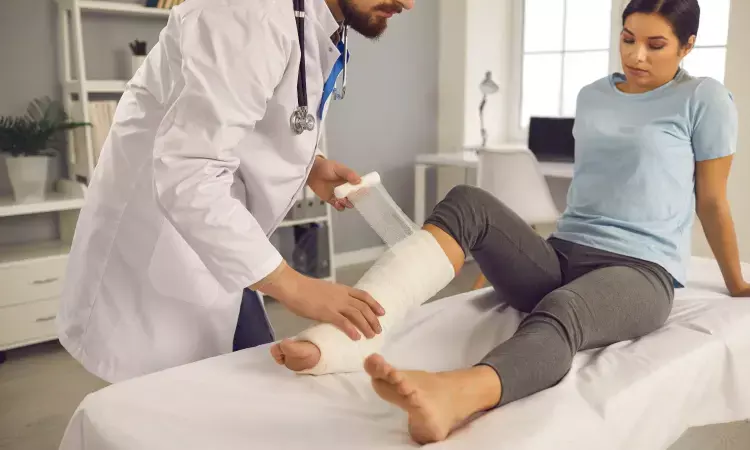- Home
- Medical news & Guidelines
- Anesthesiology
- Cardiology and CTVS
- Critical Care
- Dentistry
- Dermatology
- Diabetes and Endocrinology
- ENT
- Gastroenterology
- Medicine
- Nephrology
- Neurology
- Obstretics-Gynaecology
- Oncology
- Ophthalmology
- Orthopaedics
- Pediatrics-Neonatology
- Psychiatry
- Pulmonology
- Radiology
- Surgery
- Urology
- Laboratory Medicine
- Diet
- Nursing
- Paramedical
- Physiotherapy
- Health news
- Fact Check
- Bone Health Fact Check
- Brain Health Fact Check
- Cancer Related Fact Check
- Child Care Fact Check
- Dental and oral health fact check
- Diabetes and metabolic health fact check
- Diet and Nutrition Fact Check
- Eye and ENT Care Fact Check
- Fitness fact check
- Gut health fact check
- Heart health fact check
- Kidney health fact check
- Medical education fact check
- Men's health fact check
- Respiratory fact check
- Skin and hair care fact check
- Vaccine and Immunization fact check
- Women's health fact check
- AYUSH
- State News
- Andaman and Nicobar Islands
- Andhra Pradesh
- Arunachal Pradesh
- Assam
- Bihar
- Chandigarh
- Chattisgarh
- Dadra and Nagar Haveli
- Daman and Diu
- Delhi
- Goa
- Gujarat
- Haryana
- Himachal Pradesh
- Jammu & Kashmir
- Jharkhand
- Karnataka
- Kerala
- Ladakh
- Lakshadweep
- Madhya Pradesh
- Maharashtra
- Manipur
- Meghalaya
- Mizoram
- Nagaland
- Odisha
- Puducherry
- Punjab
- Rajasthan
- Sikkim
- Tamil Nadu
- Telangana
- Tripura
- Uttar Pradesh
- Uttrakhand
- West Bengal
- Medical Education
- Industry
Lobenhoffer approach with direct reduction of posterior fracture fragments excellent option for complex tibial plateau fractures

Posterior tibial plateau fracture (PTPF) is caused when the femoral condyle strikes the posterior tibia plateau while the knee joint, in a semi-flexion or flexed position, suffers from a varus-valgus stress.
An article published in the European Journal of Orthopaedic Surgery & Traumatology has concluded that the Lobenhoffer approach with direct reduction of posterior fracture fragments for complex tibial plateau fractures is an excellent option for the management of these injuries with the advantage of faster surgery and improved range of motion.
In this study, researchers compared outcomes of patients with posterior tibial plateau fractures who underwent repair indirectly with an anterior approach to those who underwent direct repair with a prone “Lobenhoffer” operative approach.
Forty-four patients with posterior column tibial plateau fractures underwent repair, 22 of whom were fixed using a prone Lobenhoffer approach and compared to 22 patients with similar fracture patterns treated with indirect reduction using a supine approach. Data collection at a minimum of one year included patient-reported outcome scores, pain, knee range of motion, complications, need for reoperation and radiographs for knee alignment, residual depression and fracture healing.
Key findings from the research are:
- All demographics were similar between the groups except BMI, which was lower in the prone group.
- Fracture type according to age, Schatzker and three-column classification was matched between cohorts.
- The study reported no difference related to outcomes, including pain, radiographic knee alignment, residual articular depression, functional outcome (SMFA), complications and reoperation needs.
- In the prone group, Knee flexion at one year (127.8 vs. 115.8).
- Considering the prone group, the surgical time was less, with a mean of 73.7 min vs. 82.3 min.
Concluding further, they said that the Lobenhoffer approach with direct reduction of posterior fracture fragments is an excellent approach for managing such injuries. It allows faster surgery with improved ultimate knee range of motion in posterior column tibial plateau fractures.
Reference:
Schwartz, L., Ganta, A., Konda, S. et al. The prone posteromedial approach to the knee revisited: a safe and effective strategy for posterior tibial plateau fractures. Eur J Orthop Surg Traumatol (2023). https://doi.org/10.1007/s00590-023-03755-z
BDS, MDS in Periodontics and Implantology
Dr. Aditi Yadav is a BDS, MDS in Periodontics and Implantology. She has a clinical experience of 5 years as a laser dental surgeon. She also has a Diploma in clinical research and pharmacovigilance and is a Certified data scientist. She is currently working as a content developer in e-health services. Dr. Yadav has a keen interest in Medical Journalism and is actively involved in Medical Research writing.
Dr Kamal Kant Kohli-MBBS, DTCD- a chest specialist with more than 30 years of practice and a flair for writing clinical articles, Dr Kamal Kant Kohli joined Medical Dialogues as a Chief Editor of Medical News. Besides writing articles, as an editor, he proofreads and verifies all the medical content published on Medical Dialogues including those coming from journals, studies,medical conferences,guidelines etc. Email: drkohli@medicaldialogues.in. Contact no. 011-43720751


